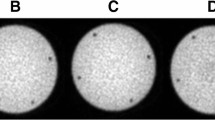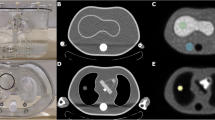Abstract
Purpose
Quantitative image reconstruction in positron emission tomography (PET) requires an accurate attenuation map of the object under study for the purpose of attenuation correction. Current dual-modality PET/CT systems offer significant advantages over stand-alone PET, including decreased overall scanning time and increased accuracy in lesion localisation and detectability. However, the contamination of CT data with scattered radiation and misclassification of contrast medium with high-density bone in CT-based attenuation correction (CTAC) are known to generate artefacts in the attenuation map and thus the resulting PET images. The purpose of this work was to quantitatively measure the impact of scattered radiation and contrast medium on the accuracy of CTAC.
Methods
Our recently developed MCNP4C-based Monte Carlo X-ray CT simulator for modelling both fan- and cone-beam CT scanners and the Eidolon dedicated 3D PET Monte Carlo simulator were used to generate realigned PET/CT data sets. The impact of X-ray scattered radiation on the accuracy of CTAC was investigated through simulation of a uniform cylindrical water phantom for both a commercial fan-beam multi-slice and a prototype cone-beam flat panel detector-based CT scanner. The influence of contrast medium was studied by simulation of a cylindrical phantom containing different concentrations of contrast medium. Moreover, an experimental study using an anthropomorphic striatal phantom was conducted for quantitative evaluation of errors arising from the presence of contrast medium by calculating the apparent recovery coefficient (ARC) in the presence of different concentrations of contrast medium.
Results
The analysis of attenuation correction factors (ACFs) for the simulated cylindrical water phantom in both fan- and cone-beam CT scanners showed that the contamination of CT data with scattered radiation in the absence of scatter removal causes underestimation of the true ACFs, namely by 7.3% and 28.2% in the centre for the two geometries, respectively. The ARC was 190.7% for a cylindrical volume of interest located in the main chamber of the striatal phantom containing contrast medium corresponding to 2,000 Hounsfield units, whereas the ARC was overestimated by less than 5% for the main chamber and by ∼2% for the left/right putamen and caudate nucleus compared with the absence of contrast medium.
Conclusion
Without X-ray scatter compensation, the visual artefacts and quantitative errors in flat panel detector-based cone-beam geometry are substantial and propagate cupping artefacts to PET images during CTAC. Likewise, contrast-enhanced CT images may create considerable artefacts during CTAC in regions containing high concentrations of contrast medium.








Similar content being viewed by others
References
Townsend DW, Carney JPJ, Yap JT, Hall NC. PET/CT today and tomorrow. J Nucl Med 2004;45:4s–14s
Hasegawa BH, Zaidi H. Dual-modality imaging: more than the some of its components. In: Zaidi H, editor. Quantitative analysis in nuclear medicine imaging. Berlin Heidelberg New York: Springer; 2005; p. 35–81
Zaidi H, Hasegawa BH. Determination of the attenuation map in emission tomography. J Nucl Med 2003;44:291–315
Antoch G, Freudenberg LS, Stattaus J, Jentzen W, Mueller SP, Debatin JF, et al. Whole-body positron emission tomography-CT: optimized CT using oral and IV contrast materials. AJR Am J Roentgenol 2002;179:1555–1560
Antoch G, Freudenberg LS, Beyer T, Bockisch A, Debatin JF. To enhance or not enhance? 18F-FDG and CT contrast agents in dual-modality 18F-FDG PET/CT. J Nucl Med 2004;45:56S–95S
Antoch G, Kuehl H, Kanja J, Lauenstein TC, Schneemann H, Hauth E, et al. Dual-modality PET/CT scanning with negative oral contrast agent to avoid artifacts: introduction and evaluation. Radiology 2004;230:879–885
Dizendorf EV, Treyer V, Von Schulthess GK, Hany TF. Application of oral contrast media in coregistered positron emission tomograhy-CT. AJR 2002;179:477–481
Nehmeh SA, Erdi YE, Kalaigian H, Kolbert KS, Pan T, Yeung H, et al. Correction for oral contrast artifacts in CT attenuation-corrected PET images obtained by combined PET/CT. J Nucl Med 2003;44:1940–1944
Nakamoto Y, Chin BB, Kraitchman DL, Lawler LP, Marshall LT, Wahl RL. Effects of nonionic intravenous contrast agents in PET/CT imaging: phantom and canine studies. Radiology 2003;227:817–824
Yau Y-Y, Chan W-S, Tam Y-M, Vernon P, Wong S, Coel M, et al. Application of intravenous contrast in PET/CT: does it really introduce significant attenuation correction error? J Nucl Med 2005;46:283–291
Dizendorf E, Hany TF, Buck A, von Schulthess GK, Burger Cl. Cause and magnitude of the error induced by oral CT contrast agent in CT-based attenuation correction of PET emission studies. J Nucl Med 2003;44:732–738
DiFilippo FP, Brunken RC. Do implanted pacemaker leads and ICD leads cause metal-related artifact in cardiac PET/CT? J Nucl Med 2005;46:436–443
Goerres GW, Hany TF, Kamel E, von Schulthess GK, Buck A. Head and neck imaging with PET and PET/CT: artefacts from dental metallic implants. Eur J Nucl Med Mol Imaging 2002;29:367–370
Goerres GW, Ziegler SI, Burger C, Berthold T, Von Schulthess GK, Buck A. Artifacts at PET and PET/CT caused by metallic hip prosthetic material. Radiology 2003;226:577–584
Kamel E, Burger C, Buck A, Von Schulthess GK, Goerres G. Impact of metallic dental implants on CT-based attenuation correction in a combined PET/CT scanner. Eur Radiol 2003;13:724–728
Goerres GW, Burger C, Kamel E, Seifert B, Kaim AH, Buck A, et al. Respiration-induced attenuation artifact at PET/CT: technical considerations. Radiology 2003;226:906–910
Osman MM, Cohade C, Nakamoto Y, Wahl RL. Respiratory motion artifacts on PET emission images obtained using CT attenuation correction on PET-CT. Eur J Nucl Med Mol Imaging 2003;30:603–606
Kanamori H, Nakamori N, Inoue K, Takenaka E. Effect of scattered x-ray on CT images. Phys Med Biol 1985;30:239–249
Colijn AP, Beekman FJ. Accelerated simulation of cone beam X-ray scatter projections. IEEE Trans Med Imaging 2004;23:584–590
Siewerdsen JH, Jaffray DA. Cone-beam computed tomography with flat-panel imager: magnitude and effects of x-ray scatter. Med Phys 2001;28:220–231
Ning R, Tang X. X-ray scatter correction algorithm for cone beam CT imaging. Med Phys 2004;31:1195–1202
Ohnesorge B, Flohr T, Klingenbeck-Regn K. Efficient object scatter correction algorithm for third and fourth generation CT scanners. Eur Radiol 1999;9:563–569
Tofts PS, Gore JC. Some sources of artefact in computed tomography. Phys Med Biol 1980;25:117–127
Glover GH. Compton scatter effects in CT reconstructions. Med Phys 1982;9:860–867
Johns PC, Yaffe M. Scattered radiation in fan beam imaging systems. Med Phys 1982;9:231–239
Joseph PM, Spital RD. The effects of scatter in x-ray computed tomography. Med Phys 1982;9:464–472
Merritt RB, Chenery SG. Quantitative CT measurements: the effect of scatter acceptance and filter characteristics on the EMI 7070. Phys Med Biol 1986;31:55–63
Endo M, Tsunoo T, Nakamori N, Yoshida K. Effect of scatter radiation on image noise in cone beam CT. Med Phys 2001;28:469–474
Malusek A, Seger MM, Sandborg M, Alm Carlsson G. Effect of scatter on reconstructed image quality in cone beam computed tomography: evaluation of a scatter-reduction optimisation function. Radiat Prot Dosimetry 2005;114:337–340
Ay MR, Zaidi H. Development and validation of MCNP4C-based Monte Carlo simulator for fan- and cone-beam x-ray CT. Phys Med Biol 2005;50:4863–885
Digby WM, Hoffman EJ. An investigation of scatter in attenuation correction for PET. IEEE Trans Nucl Sci 1989;36:1038–1042
Wegmann K, Adam L-E, Livieratos L, Zaers J, Bailey DL, Brix G. Investigation of the scatter contribution in single photon transmission measurements by means of Monte Carlo simulations. IEEE Trans Nucl Sci 1999;46:1184–1190
Dahlbom M, Hoffman E. Problems in signal-to-noise ratio for attenuation correction in high resolution PET. IEEE Trans Nucl Sci 1987;34:288–293
Bai C, Shao L, Da Silva AJ, Zhao Z. A generalized model for the conversion from CT numbers to linear attenuation coefficients. IEEE Trans Nucl Sci 2003;50:1510–1515
Tang HR, Brown JK, Da Silva AJ, Matthay KK, Price DC, Huberty JP, et al. Implementation of a combined X-ray CT-scintillation camera imaging system for localizing and measuring radionuclide uptake: experiments in phantoms and patients. IEEE Trans Nucl Sci 1999;46:551–557
Carney J, Beyer T, Brasse D, Yap JT, Townsend DW. CT-based attenuation correction for PET/CT scanners in the presence of contrast agent. IEEE Nucl Sc Symp Conf Rec 2002;3:1443–1446
Zaidi H, Scheurer AH, Morel C. An object-oriented Monte Carlo simulator for 3D cylindrical positron tomographs. Comput Methods Programs Biomed 1999;58:133–145
Ay M, Shahriari M, Sarkar S, Adib M, Zaidi H. Monte Carlo simulation of x-ray spectra in diagnostic radiology and mammography using MCNP4C. Phys Med Biol 2004;49:4897–4917
Zaidi H. Comparative evaluation of scatter correction techniques in 3D positron emission tomography. Eur J Nucl Med 2000;27:1813–1826
Berger MJ, Hubbell JH, Seltzer SM, Chang J, Coursey JS, Sukumar R, et al. XCOM: photon cross sections database. NBSIR 87–3597. 1998; http://physics.nist.gov/PhysRefData/Xcom/Text/XCOM.html
Rousset OG, Ma Y, Evans AC. Correction for partial volume effects in PET: principle and validation. J Nucl Med 1998;39:904–911
Zaidi H, Koral KF. Satter modelling and compensation in emission tomography. Eur J Nucl Med 2004;31:761–782
Berthelsen AK, Holm S, Loft A, Klausen TL, Andersen F, Hojgaard L. PET/CT with intravenous contrast can be used for PET attenuation correction in cancer patients. Eur J Nucl Med Mol Imaging 2005;32:1167–1175
Acknowledgements
This work was supported by the Swiss National Science Foundation under grant SNSF 3152A0–102143. The authors would like to thank Dr. O.G. Rousset for providing the PVC software and F. Schoenahl, T. Ruest and N. Andreini, for their valuable support.
Author information
Authors and Affiliations
Corresponding author
Rights and permissions
About this article
Cite this article
Ay, M.R., Zaidi, H. Assessment of errors caused by X-ray scatter and use of contrast medium when using CT-based attenuation correction in PET. Eur J Nucl Med Mol Imaging 33, 1301–1313 (2006). https://doi.org/10.1007/s00259-006-0086-6
Received:
Accepted:
Published:
Issue Date:
DOI: https://doi.org/10.1007/s00259-006-0086-6




